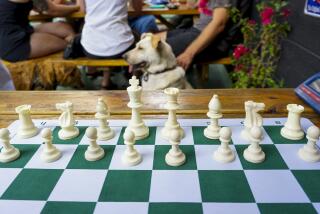Much at stake in world match
- Share via
Position No. 6104: White to play and win. From the game Tornike Sanikidze-Alexander Fedorov, Dubai 2010.
Solution to Position No. 6103: Black wins with 1… Nxa1 2 Qxa1 Qc2! 3 Rxc2 bxc2, setting up 4 … Rd1+.
The world championship match, which began Saturday in Sofia, Bulgaria, will determine the champion for the next two years. There is a hefty prize fund of 2 million euros (about $2.7 million), of which the winner will receive 60%. But even more is at stake.
Viswanathan Anand, champion since 2007, is already recognized as a great player and the instigator of India’s chess boom. However, he stood in the shadow of Garry Kasparov during his prime years and became champion only at age 37. A victory would confirm his status as the leader of the post-Kasparov era and would turn speculation to his inevitable clash with a member of a much younger generation, such as 19-year old Magnus Carlsen. If Anand cares about being remembered as a dominant figure in chess history, he must win this match.
Challenger Veselin Topalov held the top spot in the world rankings until recently being surpassed by Carlsen. He lost the 2006 world championship match to Vladimir Kramnik, and he must wonder if he will get another chance if he loses this one too.
For the World Chess Federation (FIDE), this match represents an opportunity for favorable publicity that might rehabilitate its tattered reputation. Since Kirsan Ilyumzhinov became FIDE president in 1995, the organization has followed the doomed policy of trying to promote itself rather than its stars. FIDE conducted a decade-long battle with Kasparov and offered less than lukewarm support to his successors, Kramnik and Anand. FIDE has already alienated Carlsen, but the damage could be reversed if FIDE behaves properly.
Predictions
Topalov’s edge in rating (2805 to 2787) suggests a one-point victory is slightly more probable than a 6-6 tie. I asked 10 titled players to guess the score of the best-of-12-game match.
All predicted a close match with either one or two wins by the loser, and no more than three by the winner.
The highest-rated forecaster predicted a 6-6 tie, and he said that Anand would win the speedy tiebreaking games. Two others foresaw an Anand victory by 61/2-51/2, and one guessed 61/2-41/2.
Four predicted a Topalov victory by the smallest margin, 61/2-51/2, while two thought Topalov would win by two points.
Local news
Tatev Abrahamyan took a 11/2-1/2 lead last weekend in her six-game match against another of the best local players, IM Tim Taylor. Spectators are invited to watch games beginning at 10 a.m. and 4 p.m. Saturday at the Los Angeles Chess Club, 11514 Santa Monica Blvd. in Los Angeles. The match will conclude May 8. For information about the match or any of the club’s events, call Mick Bighamian at (310) 795-5710.
For a second game and more news, go to latimes.com.
Today’s games
GM Vladimir Baklan (Ukraine)-GM Evgeny Sharapov (Ukraine), Dubai 2010: 1 e4 c6 2 d4 d5 3 e5 The Advance variation against the Caro-Kann Defense. c5 Less popular than 3 … Bf5. 4 Nf3 Often White tries 4 dxc5. Nc6 5 c4!? Bg4 Sharpest. White obtains an edge from 5 … e6 6 cxd5 exd5 7 Bb5, but 5 … cxd4 6 Nxd4 e6 (rather than the risky 6 … Nxe5 7 cxd5 Qxd5 8 Nc3) 7 Nc3 Bb4 is safe and sound. 6 cxd5 Bxf3 Nearly guaranteeing the gain of two central pawns. The consequences of 6 … Qxd5 7 Nc3 Bxf3 8 Nxd5 Bxd1 10 Nc7+ Kd8 11 Nxa8 Bh5 11 d5 are far from clear, but it will be difficult for Black to capture the trapped Knight. 7 Qxf3 Nd4 8 Qd1 Not 8 Qe4? f5. Qxd5 9 Bb5+! Kd8 10 0-0 White has scored well after 10 … e6 11 Nc3 Qxe5 12 b4, so Sharapov prefers the direct approach. Qxe5 Black might rationalize his greed by relying on his solid pawn structure. He doesn’t even trail in development. The computer claims an advantage for Black, but don’t believe it! White will activate the rest of his pieces quickly, while Black’s Rook will sit idly at h8, hampered by his inability to castle. 11 Re1 Qd6 If 11 … Qf5 12 Be3 e5, White attacks with 13 Bxd4 cxd4 14 Nd2. He may follow with Nd2-c4, Qd1-a4-a5, or even f2-f4. 12 Bc4 e6 13 b4 White needs open lines. Nf6 The third pawn provides little consolation after 13 … cxb4?! 14 Bb2 Nf5 15 Qe2, as White can use the c- and d-files. 14 Bb2 Qd7 Without making any obvious errors, Black slips into a lost position. Possibly 14 … Qb6!? 15 Nd2 Ke8 improves, although 16 Rb1 still seems promising for White. 15 Nd2 Ke8 Inserting 15 … b5?! 16 Bf1 brings no relief: 16 … Ke8 17 Nf3 Rd8 18 bxc5 Bxc5 19 Rc1 Nxf3+ 20 Qxf3, and the b-pawn becomes a target. 16 Nf3 Rd8?! From this point, White can prove a win. Black’s last hope was 16 … Nxf3+ 17 Qxf3 Be7 18 bxc5 Qc6. 17 Ne5 Qc7 18 Qa4+ Nc6 Against 18 … Nd7 19 Bxd4 cxd4 20 Rac1 Qd6, White can win with 21 Bb5, but 21 Nxf7! Kxf7 22 Rxe6 Qxe6 23 Bxe6+ Kxe6 24 Qb3+ Kf6 25 Qf3+ is even stronger. Also 18 … b5 19 Bxb5+ Nxb5 20 Qxb5+ Nd7 fails, as 21 Rad1 will recover material. 19 Nxf7! Kxf7 After 19 … Qxf7 20 Rxe6+ Be7, both 21 Rae1 and 21 b5 are sufficient. 20 Bxe6+ Ke8 Awful, but 20 … Kg6 runs into the lethal 21 Qc2+ Kh6 22 Bc1+ g5 23 Bxg5+! Kg7 24 Bxf6+ Kxf6 25 Qf5+. 21 b5! Reserving his discovery and imagining 21 … Nd4 22 b6+ Qc6 23 Bd5+. Ne7?! Toughest is 21 … Be7 22 bxc6 Qxc6 23 Qxa7 Qa6, but White clinches the win by 24 Qxa6 bxa6 25 Be5, followed by Ra1-b1-b7. 22 Be5
Qb6 23 Qc4 Threatening 24 Bc7! Qxc7 25 Bf7+ Kd7 26 Qe6 mate. Nfd5 24 Bg3, Black Resigns. He can neither move nor save the Knight at d5.
GM Sanan Sjugirov (Russia)-GM Sergey Ionov (Russia), Russian Team Championship, Dagomys 2010: 1 e4 e5 2 Nf3 Nc6 3 Bb5 Nf6 4 0-0 Bc5 The Classical defense to the Ruy Lopez, known since the 15th Century. Although the Bishop appears more active at c5, masters generally prefer to place it at e7. 5 c3 0-0 6 d4 Bb6 7 Bg5 Logically exploiting the absence of Black’s Bishop from the d8-h4 diagonal. h6 8 Bh4 d6 9 Qd3 Preparing Nb1-d2. Theory claims an edge for White, as Black must make concessions to deal with his pinned Knight. g5 Aggressive. The conservative choice, 9 … Qe7 10 Nbd2 Nb8, avoids pawn weaknesses but generates no counterplay. 10 Bg3 Nh5 Another way is 10 … exd4!? 11 Nxd4 (Black welcomes 11 cxd4 g4) Nxd4 12 cxd4 c6 13 Ba4 d5. 11 Na3 exd4 12 Bxc6 bxc6 13 Nxd4 Bd7?! Natural, but Black should not think of defense. Instead, 13 … Re8!? 14 Nxc6 Qd7 15 Nd4 Bb7, possibly followed by … d6-d5, activates the Bishops and obtains reasonable compensation for a pawn. 14 Nc4 Qe7?! The same error. He must fight back with 14 … Bxd4 15 cxd4 f5. 15 Rae1 Rae8 16 f4! In contrast, White strives for the initiative. Black’s position is uncomfortable, and his next move makes it worse. c5?! 17 Nf5 Bxf5 18 exf5 Qf6 19 fxg5 hxg5 20 Qf3 Nxg3 21 hxg3 Although White can make no immediate threat, he enjoys a decisive strategic advantage. This game disproves the Russian maxim that “The worst Bishop is stronger than the best Knight.” Kg7 If 21 … Rxe1 22 Rxe1 Rd8, White squelches … d6-d5 by 23 Rd1. 22 a4! a5 Black’s dream of … c7-c6 and … Bb6-c7 becomes less realistic. 23 Kf2 Rh8 24 Rxe8 Rxe8 25 Rh1 Rh8 A bit cooperative, but 25 … Rd8 26 Kf1 d5 27 Ne3 would also help White. 26 Rxh8 Kxh8 27 Qe4 Without the distracting Rooks, White can maneuver to land a knockout with his “extra” piece. Kg7 28 Kf3 Intending Nc4-e3-g4. Qh6 29 Kg4 Qh2 30 Ne3 c4 Freeing the Bishop, but too late. Not much sturdier is 30 … Kh6 31 Kf3 Qh5+ 32 g4 Qh2, as White breaks through by 33 Nd5 and 34 Qe8. 31 f6+! Kxf6 After 31 … Kh6 32 Nf5+ Kg6 33 Nxd6+, White finishes economically by 33 … Kh6 34 Nxf7 mate or 33 … Kxf6 34 Ne8 mate. 32 Nf5 Kg6 33 Nxd6+, Black Resigns. If 33 … Kg7 34 Nf5+, neither 34 … Kh7 35 Qe7 nor 34 … Kg6 35 Qc6+ Kh7 36 Qf6 lasts long.
More to Read
Go beyond the scoreboard
Get the latest on L.A.'s teams in the daily Sports Report newsletter.
You may occasionally receive promotional content from the Los Angeles Times.









